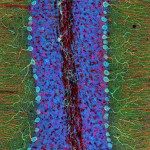Link to Pubmed [PMID] – 16380379
J. Biol. Chem. 2006 Feb;281(8):4856-66
Virus-induced expression of interferon (IFN)-A genes is regulated by two members of the IFN regulatory factor (IRF) family, IRF-3 and IRF-7, which are activated by phosphorylation during viral infection by the IKK-related serine/threonine kinases TBK1 and IkappaB kinase epsilon (IKKepsilon). In this study, we demonstrate that three IRF-binding sites located in the virus-responsive element mediate the transcriptional activation of the IFN-A4 promoter by IRF-3. The precise arrangement of these IRF elements is required for synergistic activation of the IFN-A4 promoter following Newcastle disease virus infection or activation by TBK1 or IKKepsilon. The ordered assembly of IRF-3 multimers on the promoter also determines cooperative recruitment of IRF-3 and CREB-binding protein and differential virus-induced expression of IFN-A4 gene promoter compared with IFN-A11. Naturally occurring nucleotide substitutions disrupt two of the IRF elements in the IFN-A11 gene promoter, leading to a dramatic decrease in IRF-3 and CREB-binding protein recruitment and in IRF-3-dependent transcription. Transcription of the IFN-A4 promoter by IRF-7 is mediated by two IRF elements; promoter mutants that carry a reversed IRF element retain the ability to respond to IKKepsilon or TBK1 expression in the presence of IRF-7 but lose the capacity to respond to virus or kinase-induced IRF-3. Interestingly, IKKepsilon or TBK1 stimulates the IRF-7-mediated transcription of IFN-A11, although at a lesser extent compared with IFN-A4. Our data indicate that virus-induced expression of IFN-A genes is dictated by the organization of IRF elements within the IFN-A promoters and that the differential IFN-A gene expression, based on the IRF-3 responsiveness, is partially compensated in the presence of IRF-7 when both factors are activated by IKKepsilon or TBK1.

